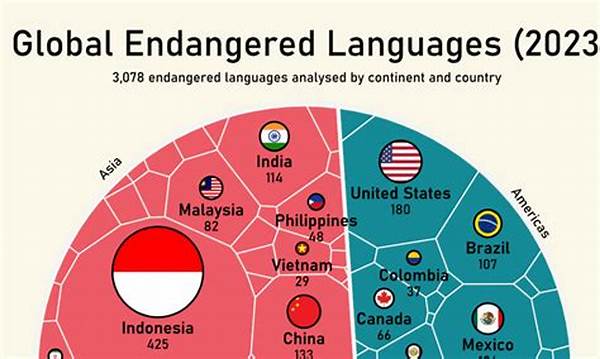Imagine a world without diverse languages. Picture the silence of ancient words, rich dialects, and unique expressions fading away into oblivion. It’s a daunting thought, isn’t it? Yet, this scenario isn’t just a figment of imagination; it’s a harsh reality for thousands of endangered languages across the globe. But here’s the good news—audio visual history sources are emerging as key players in saving these linguistic treasures. Through the magic of film, communities are given a voice, and endangered languages find a stage to revive, thrive, and survive for future generations.
Read More : Latest Audio Visual Trends In Digital Broadcasting For 2025
In an era where digital media reigns supreme, leveraging audiovisual content to capture and preserve the richness of language and culture is both innovative and necessary. Think of it as a dynamic duo—language preservation meets the power of visual storytelling. This combination not only documents languages but also enlivens them, transforming endangered tongues into vibrant auditory and visual experiences. So, grab your popcorn, and let’s delve deep into how this fascinating intersection of film and language is rewriting the playbook on language preservation!
The Power of Film in Language Preservation
Film as a Cultural Time Capsule
Have you ever seen a film that struck a chord so deeply that it transported you back in time or to a faraway land? Films can be powerful cultural time capsules, capturing the essence of a moment, a belief system, or a language. In the context of endangered languages, films serve as a vibrant canvas where native speakers can communicate their narratives, customs, and wisdom. This isn’t just about documenting words; it’s about showcasing the nuanced tones, accents, and stories that make each language unique.
Amplifying Voices, One Scene at a Time
Through strategic storytelling and catchy screenplay, films have the potential to amplify voices of marginalized communities. Language is intertwined with identity, and by showcasing endangered languages in film, filmmakers provide visibility and recognition to cultures that might otherwise remain hidden. Unique selling point alert—films don’t just entertain; they educate and advocate! By capturing the hearts and minds of viewers, films create a desire to learn, appreciate, and preserve these linguistic jewels.
Statistics & Research: The Impact of Films
A report by UNESCO indicates that a language disappears every two weeks. With over 7,000 languages spoken globally, more than 40% are at risk of vanishing. Here’s where filmmaking steps in—not just as an art form, but as an educational tool that sparks curiosity and promotes language learning. Studies show that visual and auditory content stimulates different parts of the brain, making learning more engaging and effective. Pair this with the emotional resonance of storytelling, and you’ve got a persuasive call-to-action that encourages linguistic preservation.
Unpacking the Process: How Films Protect Linguistic Heritage
The Storybehind the Screen
Creating films that preserve language is no small feat. It involves extensive research, consultations with language experts, and genuine engagement with the community. Documentarians take a journalistic approach, conducting interviews and delving deep into linguistic nuances. They focus on authenticity, ensuring that the film is not just a form of entertainment but a genuine representation of the language and culture it portrays.
Promotional Strategies: Lights, Camera, Advocacy
To maximize the impact of language preservation films, strategic marketing is employed. Through both traditional and digital platforms, these films are marketed as educational resources, cultural artifacts, and advocacy tools. Social media campaigns, film festivals, and partnerships with educational institutions help drive interest and ensure these films reach a broader audience. Exclusive screenings and interactive Q&A sessions with filmmakers further enrich the audience’s understanding and engagement.
Audio Visual History Sources Saving Endangered Languages Through Film: A Multi-Faceted Journey
Films act as powerful mnemonic devices, reinforcing language through repetition and emotional connection. They offer practical applications, such as language learning aids in classrooms, significantly contributing to the revival and maintenance of endangered languages. As audio visual history sources, films capture oral traditions and integrate them into visual narratives, ensuring a permanent and poignant record of language.
Why It Matters: A Call to Action
Picture a future where no language is left unspoken, and every dialect finds its voice. This is the vision that drives filmmakers, linguists, and cultural enthusiasts who dedicate their work to preserving linguistic diversity. While the journey is fraught with challenges, the triumphs are immeasurable. By leveraging the power of films, we join a global movement—one that champions diversity, fosters understanding, and enriches humanity’s cultural tapestry.
Read More : Audiovisual Packages For Campus Events
Exclusive Insight: The Emotional and Rational Appeal
Endangered languages are not merely linguistic oddities; they are critical to understanding human history, identity, and diversity. Films provide an emotive touch, connecting the audience to the plight and beauty of these languages. Simultaneously, they offer a rational appeal, presenting concrete data, statistics, and testimonies that highlight the importance of action and advocacy.
The Future of Language Preservation: A Cinephile’s Perspective
So, what’s the next step? It’s simple: get involved, spread the word, and support films dedicated to language preservation. Whether you’re a cinephile, a linguist, an educator, or simply someone passionate about culture, there’s a role for you in this cause. Attend film screenings, share films on your social media, or collaborate with nonprofit organizations focused on language preservation. After all, every view, like, and share counts.
Film is more than just entertainment—it’s a cultural ambassador, an educator, and an advocate. Through it, endangered languages of the world find a beacon of hope. So, let’s roll out the red carpet and celebrate the cinematic revolution that is saving languages, one film at a time.
—
In conclusion, audio visual history sources, specifically through film, are a transformative force in safeguarding endangered languages. This remarkable integration of storytelling and linguistic preservation serves not only to document but also to revive and celebrate our world’s incredible linguistic diversity. It’s time to join this cinematic movement and ensure no language is left behind.
